UNIVERSITY
SCHOOL
Athletes Often Become Wonderful Teachers and Mentors




UNIVERSITY
SCHOOL



■ BY GREG LATSHAW
After being paused for two years, the undergraduate dance minor returned to the University of Pittsburgh School of Education in fall 2024. The curriculum was updated to reduce the number of required credits, offer more flexibility through additional electives, and emphasize a movement science perspective grounded in exercise science.
How has the response been from prospective students so far?
“Amazing,” says program coordinator Sally Sherman. Sherman is even hearing from high school students who are factoring the program into their decision on whether to attend Pitt. “There are students who are choosing Pitt because their major exists at several universities, but the dance minor is only here,” says Sherman, an associate professor of practice at Pitt Education. “They have another interest for their career, but they don’t want to move dance to the backburner of their lives just yet.”
The desire to keep dancing in college is true for Pitt students Emma Ryan and Sadie Stetser. Both are on track to graduate this spring, and while they were affected by the dance minor’s pause, both will complete the minor on time.
Ryan, who is earning a bachelor’s degree in psychology and a certificate in American Sign Language, has been dancing since she was 2 years old. She likes that the minor has allowed her to continue “doing what I love while looking at dance in new ways,” including learning about first aid and CPR.
“The dance minor was one of the things that drew my eye to Pitt in the first place, so I’m glad they were able to bring back a new version,” says Ryan. After graduating, she plans to enroll in Pitt’s occupational therapy doctoral program.
Stetser, who is majoring in law, criminal justice, and society, also has been dancing since she was young and has enjoyed the dance minor’s classes in ballet, jazz, modern dance, party dance, and dance production. After graduation, law school is in her future. She says that she’ll always be grateful for her dance experience at the School of Education.
“This program is great for those who wish to continue dancing in college or those who wish to be dance instructors someday,” she says. “But even someone with a minor interest in dance should consider pursuing this minor. The instructors within the program are great at adapting their lesson plans for people at all skill levels. If you like to dance, you will enjoy the dance minor.” ■
Enrollment Term Fall, Spring, or Summer
Credits 15
Application Deadline Rolling Admissions
Duration On average, it takes 2 years (4 semesters) to complete this minor.
Time Commitment
Full-Time or Part-Time
Learn more about the University of Pittsburgh’s Dance Minor program: education.pitt.edu/program/minor-in-dance/

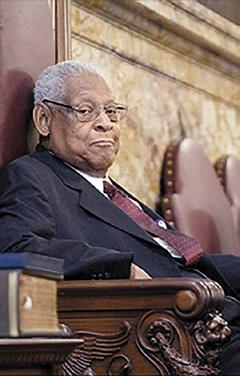
■ BY GREG LATSHAW
In fall 2024, the University of Pittsburgh School of Education began sponsoring a new education-themed learning community that is reaching more than 400 first-year students at Pitt.
Named after K. Leroy Irvis, a Pitt School of Law alumnus and the first Black speaker of the Pennsylvania House of Representatives, Irvis Hall is located on upper campus above the Victory Heights athletics complex that is now under construction. It is home to one of the 17 first-year Living Learning Communities (LLCs) on the Pittsburgh campus centered on a distinctive theme or academic interest area.
The Irvis Hall LLC’s theme is Education, Leadership, and Social Change. While not all students are future education majors, they are being invited to explore themes around community involvement, identity development, and social justice.
Faculty advisor Rosa Maria Acevedo, assistant professor of practice at Pitt Education, has organized activities to challenge students’ thinking. There have been TED-style talks given by Pitt Education PhD students, a lecture on self-care by Pitt Education faculty member Sergio Gonzalez, a stress-free zone during fall finals week, and a Donuts with the Dean event with Renée and Richard Goldman Dean Eboni M. Zamani-Gallaher and Vice Provost for Student Affairs Carla Panzella. ■

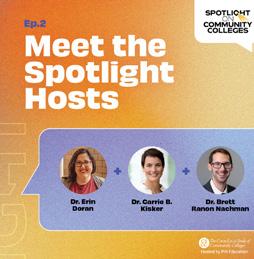
“Spotlight on Community Colleges” is a new podcast series from the Council for the Study of Community Colleges (CSCC), which is housed at the University of Pittsburgh School of Education. Renée and Richard Goldman Dean Eboni M. Zamani-Gallaher serves as executive director of the CSCC. The series aims to provide insights into the major challenges and issues faced by community colleges and to shine a light on those who attend, teach at, and lead the institutions. Episode 2 featured Pitt Education Assistant Professor Brett Ranon Nachman, a cohost of the podcast, who shared his research and experiences at community colleges.
“Spotlight on Community Colleges” is available on Apple Podcasts, Spotify, and wherever you get your podcasts. You can download from Spotify by scanning this QR code:

■ BY GREG LATSHAW
In January 2025, the University of Pittsburgh School of Education became registered with the American College of Sports Medicine (ACSM) Exercise is Medicine On Campus (EIM-OC) program. As a partner institution, Pitt Education will offer health, fitness, and mindfulness programming to students, faculty, and staff across the entire Pitt community.
“We want to make sure that everyone is physically active because physical activity is a vital sign of health,” says Zack Wilson, an assistant professor of practice at Pitt Education and the program’s faculty advisor.
Pitt Education is one of approximately 200 registered schools nationwide in the ACSM EIM-OC program. Joining the program required an application with the involvement of Pitt Education’s exercise science faculty, two students who are members of ACSM, and a nurse practitioner and mental health professional from other units at Pitt.
Programs that are already under way include free yoga classes, and future activities may include strength training, high-intensity interval training workouts, and walking groups.
The effort also is creating hands-on learning opportunities for students enrolled in the school’s exercise science and exercise physiology programs, as they will play a large role in the creation and implementation of the programs.
“This is for all aspects of health, mental and physical. It’s focused on creating a better version of yourself,” says Navreen Kaur, an MS student in clinical exercise physiology who is working on the project.
To learn more or get involved, contact eimpitt@pitt.edu. ■


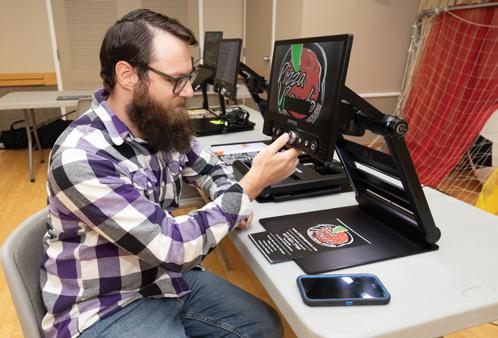
The University of Pittsburgh School of Education’s visual impairment and blindness programs are now in rare company after receiving full accreditation from the Association for Education and Rehabilitation of the Blind and Visually Impaired. The accreditation, which followed a review of more than 400 curricular and faculty standards, applies to the school’s teacher of students with visual impairments (TVI) and orientation and mobility (O&M) specialist academic programs. Pitt Education has the only accredited TVI program in Pennsylvania and is one of five accredited programs nationwide. Additionally, Pitt Education has one of only two accredited O&M programs in Pennsylvania.
“For years, our students have told us that they feel prepared and have shown that by having a nearly 100% pass rate on their certification exams,” says Tessa McCarthy, associate professor and program coordinator for the O&M program. “This is just one more indication that we are doing what we should be doing.” ■
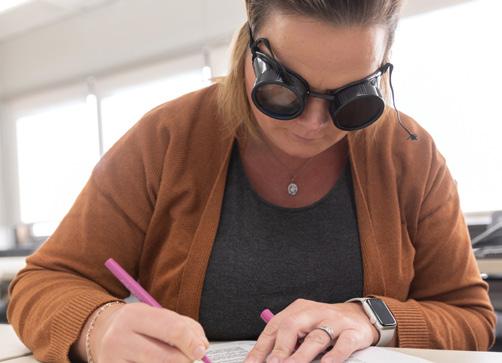
■ BY GREG LATSHAW
In her time as a certified yoga instructor, University of Pittsburgh School of Education Associate Professor of Practice Sally Sherman has enjoyed quite a few moments of zen, but few experiences compare to the pure joy of Yoga Day at PNC Park, home of the Pittsburgh Pirates.
For going on a decade, Sherman has taught a yoga class every summer on the park’s pristine outfield grass. As many as 3,000 people have joined her at once for the class, which she frequently coteaches with other Pitt Education faculty members and students in the school’s exercise science and clinical exercise physiology programs.
“I love it because it’s not necessarily a yoga group. A lot of people just want to come and lay in the outfield, and I love those people,” says Sherman with a chuckle.
Originally called Oms in the Outfield, the yoga class is beginner friendly. What it lacks in peaceful relaxation, it makes up for in the location. Participants can watch the instructors on the jumbotron and enjoy the view from the outfield, seeing the ballpark from the vantage point of the players.
“While you are in center field and doing yoga, you’re looking at the entire skyline of the city, and it is gorgeous. It’s just stunningly beautiful,” says Sherman. ■
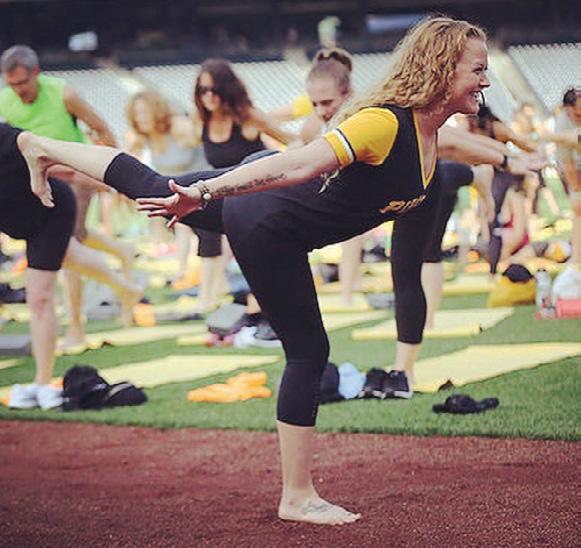


■ BY GREG LATSHAW
From Duck-chul “DC” Lee’s office at the Oak Hill research center, it’s a short walk to the fully equipped gym downstairs. On a cold winter day in February, the gym is buzzing with activity. Many of the regulars have stopped by to use the treadmills and lift weights.
Getting in shape isn’t the only motivation for this group. They also are paid participants in a major clinical research trial.
Lee is principal investigator of DoReps, or Doseresponse to Resistance Exercise on Cardiovascular Health. The five-year $3.5 million study, funded by the National Institutes of Health, seeks to determine the optimal amount of resistance exercise (such as weightlifting) to combine with aerobic exercise (such as running) to reduce the risk of heart-related issues.
The study is one of several research initiatives under way at the University of Pittsburgh School of Education’s Physical Activity Research Center (PARC). Established in summer 2024, PARC carries on the legacy of the school’s former Physical Activity and Weight Management Research Center, which previously occupied the space.
“The research data are the bottom line, the foundation of what we do,” says Lee, director of PARC and professor at Pitt Education. “We also work on how to implement what we found to mirror human life, to make everybody’s life more active and fit.”
In addition to its robust gym space, the PARC facility includes advanced medical testing machines like DEXA scans for body composition and bone density, SphygmoCor XCEL for assessing arterial stiffness, and a Biodex tool for measuring isometric muscular strength. There also is a metabolic cart for cardiorespiratory fitness testing and polysomnography equipment for sleep analysis. The facility even has a wet lab for processing and storing blood and other biospecimens at sub-zero temperatures.
“It’s a perfect setup for researchers wanting to conduct behavioral intervention studies,” says Christopher Kline, associate professor at Pitt Education and a researcher at PARC.
PARC is home to multiple labs run by Pitt Education faculty. Areas of study include the impacts of exercise on sleep, assessing handgrip strength as a biomarker of heart health, and community-based interventions for family health.
In its first year, PARC has established its own website (parc.pitt.edu) and mobilized support from faculty in the school’s Department of Health and Human Development. There are 21 faculty and staff members at PARC, including five newly hired postdoctoral students and graduate student assistants.
“We have a sincere belief of exercise for all,” says Lee. “This helps us promote and implement an active lifestyle for everyone regardless of who they are, where they live, or what they do.”

This mindset applies to PARC researchers as well.
Upstairs, in the second-floor lobby at Oak Hill, is Mike’s Bike Spot. The space honors a former employee who tragically lost his life in a bicycle accident and also is used as an indoor bike storage area for those who commute on two wheels. It’s part of the PARC culture to keep an active lifestyle, Lee says.
“We practice what we preach.”
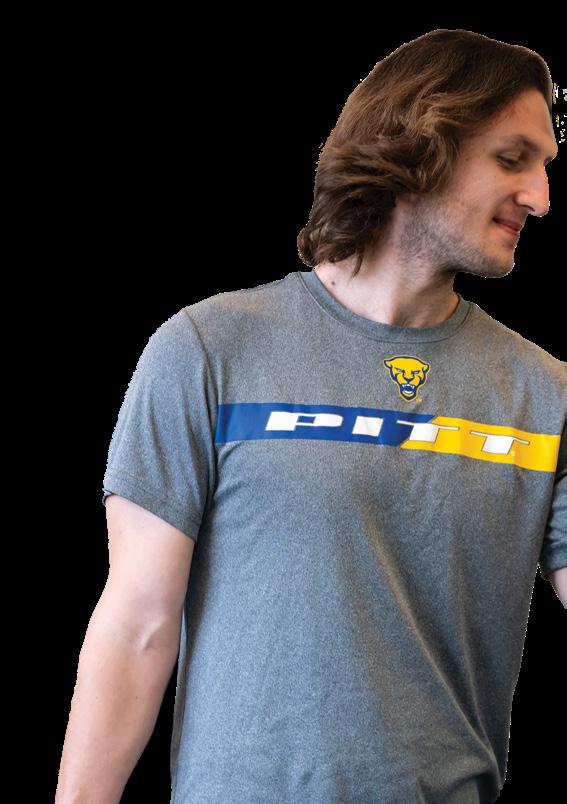



Meet the Director
Duck-chul “DC” Lee joined Pitt Education and became PARC director in June 2024. As a physical activity epidemiologist, he conducts research into the effects of active lifestyles on people’s health and longevity. Prior to joining Pitt, he worked at the Iowa State University College of Health and Human Sciences.




SLEEP SCIENCE
Led by Christopher Kline, the ExerSleep Lab explores the interrelationships of sleep and physical activity.
FAMILY HEALTH
Coordinated by Associate Professor Sharon Ross, the Family Health Lab is centered on child, youth, and family well-being.
EXERCISE PHYSIOLOGY
Coordinated by DC Lee, the Physical Activity Epidemiology Lab researches how exercise impacts cardiovascular health, diabetes, cancer, and other areas.
ISOMETRIC TRAINING
Coordinated by Assistant Professor Benjamin Gordon, the Pittsburgh Iso-Tension Lab studies the impact of a handgrip exercise to measure heart health.
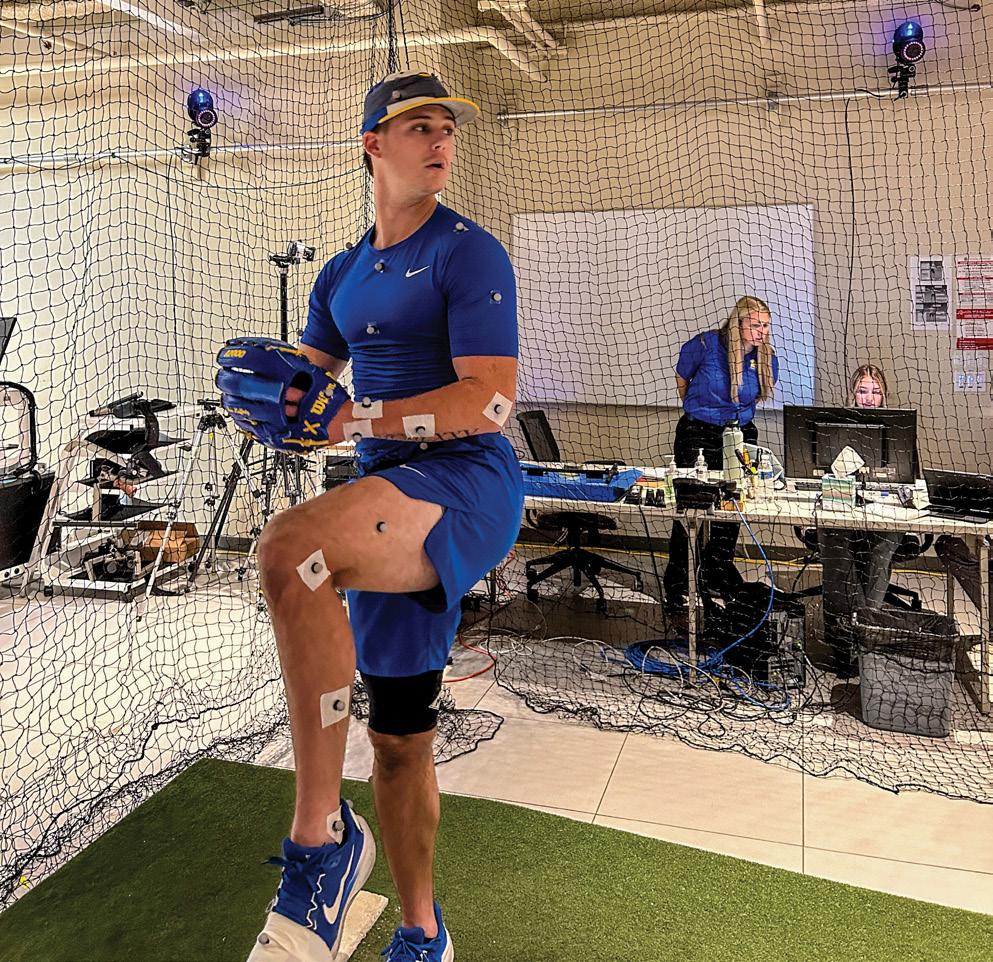







The most elite pitchers can throw blistering fastballs that register 100 miles per hour on the radar gun and deadly breaking balls that nose-dive right as the batter starts to swing. How can understanding the science behind their pitching motions be used to improve performance and reduce the risk of injury?
Researchers at the University of Pittsburgh are working with the Pitt baseball team to answer these questions through a project assessing the biomechanics of the players. The first round of measurements was taken in fall 2024 with an assessment of more than a dozen members of the pitching staff. Later this year, the hitters will be assessed, followed by an analysis of the pitchers.
“In general, biomechanics and motion capture provide an understanding of how we move, how we can improve movement efficiency and effectiveness, why injuries occur, and how to prevent or reduce these injuries,” says April Chambers, an associate professor in Pitt’s School of Education.



by
■ BY GREG LATSHAW

The data can protect the health of players and give the team a competitive edge.
“We use biomechanical equipment to identify key metrics such as elbow torque, arm speed, and body angles or velocities at critical time points in the throwing motion. Pitching with elbow torques that are too high are associated with injuries such as ulnar collateral ligament [UCL] tears, which are season-ending injuries that require Tommy John surgery [named after the first Major League Baseball pitcher to undergo this surgery],” says Chambers. Chambers, who has a secondary appointment in the Swanson School of Engineering Department of Bioengineering, is leading the project along with several students studying exercise science and bioengineering. The project’s data are collected in the state-of-the-art Motion Capture Lab, which is part of the Swanson School’s Human Movement and Balance Laboratory.


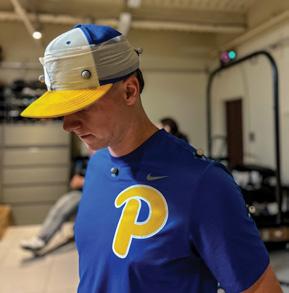


The Pitt baseball pitchers have come to the lab to have their pitching motion data recorded. Sensors were placed on the pitchers’ bodies to track and record their movements. The information from the sensors was then mapped onto a computer screen in real time to create a three-dimensional virtual skeleton. Additionally, force plates were installed into custom-built baseball surfaces to
“We put them through their movements like pitching and then assessed how we can calculate things like stress, torque, inefficiencies, all of that,” says research team
From the Lab to the Baseball Diamond

Chambers says that it helps that two of the research team members are baseball players. They can be a bridge to help translate the results.
Freure, an undergraduate student in exercise science at Pitt Education, is a former Pitt pitcher who was drafted by the Houston Astros in 2018 and later spent time in the Atlanta Braves organization.

The other student working on the project, Brock Cunningham, a junior in Pitt’s bioengineering program, is a catcher on the club baseball team. In high school, he suffered the dreaded UCL injury to his elbow.
“That’s what we’re trying to prevent through this project,” says Cunningham.
Both he and Freure agree that the data they’re collecting would have been useful to them as players.
“I pitch, and I know how a throw works and what the delivery is supposed to look like,” says Freure, “but I never knew the why and how. It’s been really nice to dive into that.”
Another critical biomechanical component of the throwing motion is the kinematic sequence, or the way the body moves during the pitch. Measures of maximum shoulder external rotation, elbow flexion, trunk rotation, and hip-to-shoulder separation can be used by the coaches and the training staff to improve a pitcher’s performance.
“There are body positions and movements that should happen in a certain order and at specific time points during the throw for optimal performance,” says Chambers.
The kinematic sequence determines how efficiently a pitcher transfers energy from the ground up through their legs and trunk, into their arm, and finally into the ball. Improving this sequence can increase a pitcher’s throwing velocity as well as reduce injury risk.
“For example, if a pitcher is not effectively using their legs to generate and transfer energy up the kinetic chain, they might compensate by overusing their arm. This would result in elevated arm torques and a higher risk of injury,” says Chambers.
The Pitt baseball team had just started its season when the research team delivered the first results in February. Coaches who were on the call work in player development, sports science, and strength and conditioning.
“It was cool to get some info on things you can’t see with your eyes—things like your degrees of rotation, velocity, the sequencing of the pelvis starting the rotation first and then your trunk and elbow,” says Matt Gilbertson, the team’s director of player development. “My first question was, “How do we apply this?”
According to Chambers, it’s unusual for a college baseball team to have access to advanced motion-capture biomechanics data. This information is more common at the major league level.
The partnership came about through the support of Pitt’s Office of Innovation and Entrepreneurship. Evan Facher, vice chancellor for innovation and entrepreneurship, helped to facilitate the connection between Pitt’s Department of Athletics and the researchers.
“When we look at innovation broadly, a lot of it happens because you put random pieces together, and the result is something you never thought you’d be able to achieve separately,” says Facher. “In this case, it was putting together a head baseball coach with a faculty member with expertise in biomechanics. On most campuses, those interactions don’t happen. But we’ve been able to break down silos.”
Pitt researchers already hold patents for wearable baseball devices and sensors. Chambers says that the biomechanics data collected by this project are the first step in the process for the future commercialization of additional devices.
“This is a long-term collaboration with Pitt baseball,” says Chambers. “The next step is to bring in the hitters for an evaluation. We’ll have a batting cage in the lab with an instrumented batting box to assess the forces under their feet and their legs as they do different swinging motions.”
Chambers also is open to new projects with other Pitt teams; softball and volleyball players, for instance, have similar motions that could be captured in the lab. She says that projects like these are great learning experiences for students in Pitt Education’s exercise science and clinical exercise physiology programs as well as those in the Swanson School.
Cunningham, who plans to continue his study of shoulder motions after graduating, is looking forward to seeing what comes next in the project.
“These athletes are already at the Division I level, so they’re already doing something right. But if we can get them to the next level, the minor league or major league, we can give them that much more of an edge,” he says. ■
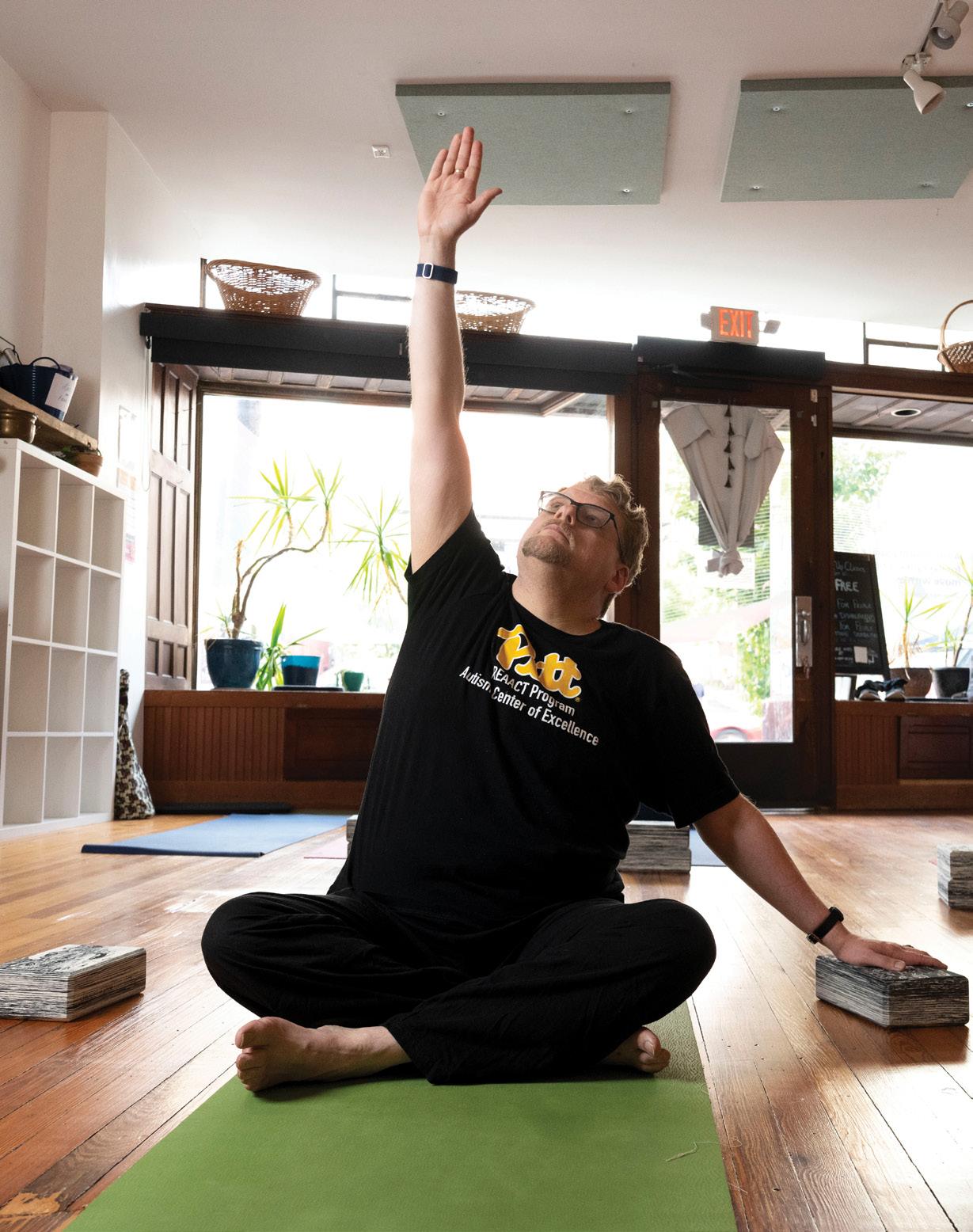
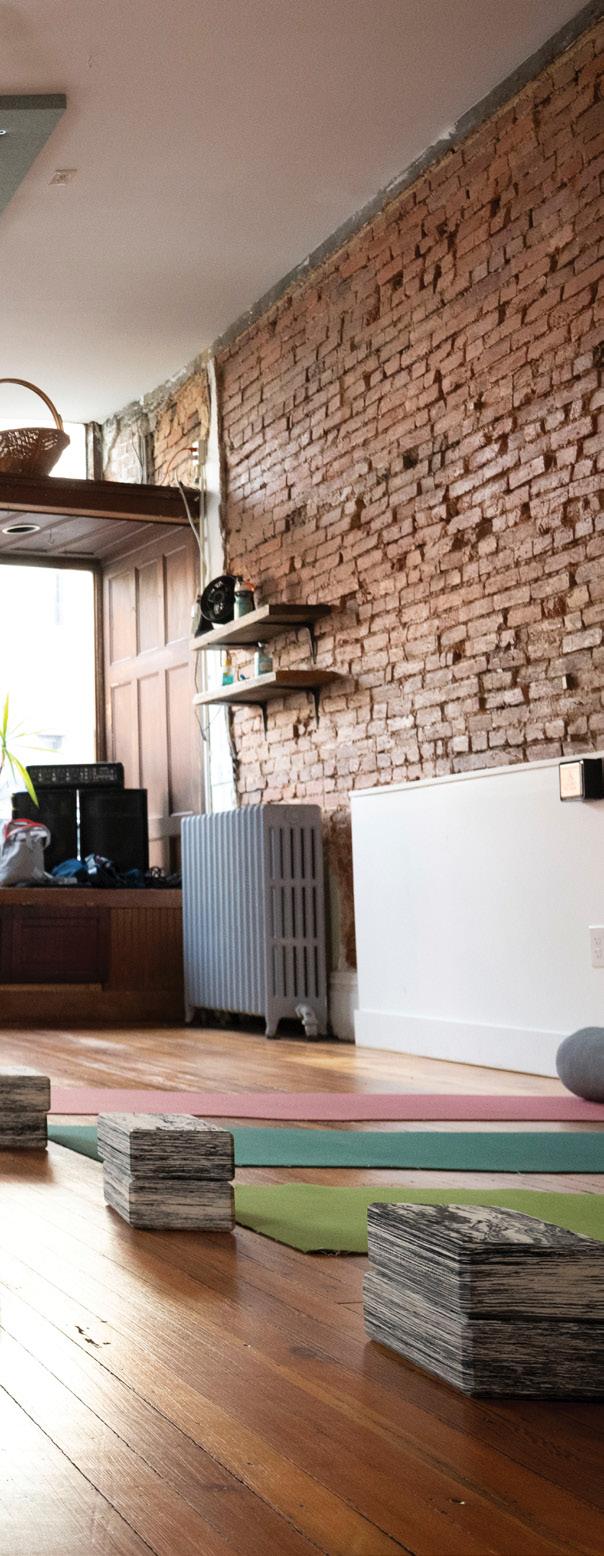
■ BY GREG LATSHAW
Scott Nicolson had never tried yoga before coming to Open Up, a yoga studio in Pittsburgh’s Lawrenceville neighborhood.
“It was intimidating at first,” he says. “I am in shape if you consider round [to be] a shape ”
Nor did he consider himself to be physically gifted. “I’ve never been anything resembling athletic unless you count running around a restaurant kitchen when I was younger,” he jokes.
Over time, the 43-year-old’s yoga skills have improved. He can now “manage an approximation” of the downward dog pose. He learned the warrior one and warrior two poses. Balancing himself on one foot, while still far from easy, has become a possibility rather than a distant aspiration. Additionally, his stretching and flexibility have improved dramatically.
The physical progress is gratifying. What means the most, though, is the sense of community Nicolson feels at Open Up. That’s because the yoga classes there were designed specifically for people like him: people with autism.
“As autistic people, we tend, I think, to kind of isolate ourselves because—no offense—neurotypical people are weird. You all are very noisy. It meant a lot to be in community with people like me and the understanding that comes with not having to try to be something that you’re not, like not forcing yourself to make eye contact,” says Nicolson.
Offering a free yoga class for adults with autism is unheard of at most yoga studios, but it’s part of the core mission of Open Up. Now in its 10th year, the nonprofit organization has offered free programming for people with disabilities, including those who are deaf, blind, or visually impaired and those who have physical disabilities. The studio also offers free yoga classes for adults without any disabilities.

“We opened the studio to offer free programming pretty much every day of the week for people with and without disabilities around the idea of building connections and understanding around those people who may not necessarily interact,” says Marissa Vogel (MEd ’12), a cofounder of Open Up and a graduate of the special education teaching program at the University of Pittsburgh School of Education.
Nicolson began attending the yoga classes at Open Up in response to an invitation for an autism study being led by researchers at Pitt Education.
The study, titled Supporting Wellbeing in Autistic Adults through Yoga, or SWAY for short, is led by Vogel; Pitt Education faculty members Rachel Robertson, Sally Sherman, and Phillandra Smith; and special education PhD students Dylan Kapit and Xiaofan Zhang.
Robertson says that the project aims to produce evidence that yoga can support the mental and physical well-being of autistic adults. The issue is of great concern because prior research shows that autistic adults are less likely to have positive mental, emotional, and physical outcomes as well as less likely to participate in physical and community activities than neurotypical adults.
“The goal we all share is to support well-being of autistic individuals, folks on the spectrum, who often have trouble accessing spaces like yoga studios or mindfulness classes,” says Robertson.
In spring and summer 2024, Project SWAY’s pilot study observed eight participants, including Nicolson, who were all autistic adults living independent lives. Over a 10-week period, they took weekly classes at Open Up and their health was measured in areas that include heart rate; blood pressure; weight; body mass index; and a measure called autistic flourishing, which is a rating scale for positivity on mental health. Participants ranged in age from their 20s to their 60s. Pre- and post-test measures were compared.
While participants’ health metrics improved, one of the most pronounced changes, according to the researchers, was the perceived socialization benefits.
Zhang noticed that when the study began, there was little talking. Everyone was on their phones instead. As the weeks progressed, the chitchat picked up. The curriculum was designed to encourage conversation by beginning and ending each class with an invitation for the yoga participants to share something from their daily lives. Over time, people started talking more freely. Soon there was so much chatter in the room that it became a distraction when Zhang needed to take participants’ physiological measurements after class for the research study.
“By the end of it, everybody talks. Everybody talks so much. ‘Could you be a little quiet? I’m measuring a person’s blood pressure here,’” says Zhang.
Kapit, who uses they/them pronouns, observed the same thing in the interviews they conducted with the participants about their experiences in the yoga classes. Kapit, who also is autistic, says that people opened up to them in a way they wouldn’t with others.
“Something I know from the work I do is that people are more open and honest and candid with other members of the community. The number-one thing I got from those interviews is that people really appreciated being in community with other autistic people,” says Kapit.
Through the project, Kapit was invited to join the board of Open Up. Kapit adds a more trans-inclusive perspective to the organization’s leadership team, even though they have yet to fully embrace yoga.
“It’s kind of amusing that I’m on the board of a yoga organization and I refuse to incorporate it into my personal life,” says Kapit.
Building Community through Inclusivity
Project SWAY has received support from the University of Pittsburgh and the School of Education.
In 2023, the project received a highly competitive Pitt Momentum Funds Teaming Grant of $60,000 and an internal seed grant from Pitt Education to lay the groundwork for the project. In fall 2024, two of the project’s investigators, Robertson and Vogel, were selected to participate in Pitt’s competitive Community Engaged Scholarship Project Development Cohort.
“The thing that stands out to me about this project is how it ties into the ‘We learn with and from communities’ part of the school’s mission-vision,” says Robertson. “The project is so community engaged, and we’ve learned so much from the Open Up leadership and the autistic adults we’ve partnered with.”
THE THING THAT STANDS OUT TO ME ABOUT THIS PROJECT IS HOW IT TIES INTO THE ‘WE LEARN WITH AND FROM COMMUNITIES’ PART OF THE SCHOOL’S MISSION-VISION. “ “ Rachel Robertson

A year before beginning the research project, the Project SWAY team held classes for autistic adults who required the assistance of an outside support person who attended classes with them. Some of the autistic adults were nonverbal, had physical disabilities, and were prone to making loud vocalizations.
“An advisory panel of autistic adults helped us to think through how to create this class that would be supportive for autistic adults. The panel said that instead of making the class open to anyone on the spectrum, you’d need different classes,” says Robertson.
This May, Sherman presented data from Project SWAY at an American College of Sports Medicine (ACSM) conference in Atlanta, Georgia. She has previously conducted research funded by the National Institutes of Health demonstrating the health benefits of yoga but had never studied the impact of it on autistic populations.
“People with autism tend to get less physical activity than people who are not autistic. I really saw this as a way to get this community some physical activity,” says Sherman.
Robertson says that the team is exploring additional funding opportunities to continue the research. For

example, there is a call for proposals from the National Institutes of Health for health interventions like yoga that can be offered via remote technologies.
The study is both filling in an important gap in the research and making a positive difference in people’s lives. That fits well with the mission of Open Up, says Vogel. While Project SWAY is focused on people with autism, broader themes of being more welcoming and inclusive are applicable to everyone, she says.
“At Open Up, our programs are for people with and without disabilities. We all have within ourselves the resources to feel better about ourselves and the world around us. Know that you can do that for yourself and others. It’s really important to remember that right now.”
Nicolson says that he appreciates how the yoga classes helped him to get more in shape. When he began learning the poses, “the first time I did it, I couldn’t believe it,” he says. The people he met along the way are what he treasures the most.
“Setting aside the physical aspect, the thing I found most rewarding was being in community with other people on the autism spectrum.” ■



Usually, professors walk into a classroom to be met by students and the backs of their laptops under the glow of overhead fluorescent lights and little fanfare. But every so often, a few professors get to walk out to a cheering crowd, donning a sash under the Friday night lights. They aren’t dreaming: This is the honor of being named an MVP—a Most Valuable Professor—at the University of Pittsburgh.
Several faculty members from the Pitt School of Education have been honored by the student-athletes in their classes through ceremonies held by their respective teams. It’s a resplendent way for students to show their appreciation for the support they receive in the classroom.
“I have a soft spot in my heart for student-athletes,” says Elizabeth “Betsy” Nagle, associate professor of practice and associate cochair of the Department of Health and Human Development.

A former student-athlete herself (she was a swimmer for Pennsylvania State University), Nagle says that she understands the juggling act they face during their time in college.
“I think my previous experience has allowed me to have tremendous respect for today’s current student athletes because of their commitment to both their academics and their sport,” Nagle said, adding she makes it a priority to attend as many games, meets or competitions of her students as possible.
“They appreciate that we work with them on their schedules and help get them what they need,” says Nagle. Additionally, increased collaboration with Pitt’s Academic Support Services for Student-Athletes program has made it more viable for student-athletes to enroll in the School of Education due to the faculty’s being extra supportive when it comes to students’ unusual schedules and course assignments when they can’t physically be in class. Nagle calls it a “blossoming partnership.”
Nagle is among the many School of Education faculty members who have been recognized at Pitt sporting events as Most Valuable Professors. Other recipients have included Christopher Kline, Kevin McLaughlin and Carma SprowlsRepcheck. They have stood before cheering crowds at volleyball games in the Fitzgerald Field House, at women’s soccer games at Ambrose Urbanic Field, at swim meets at the
Trees Hall pool, and at football games at Acrisure Stadium.
Zack Wilson, an assistant professor of practice, was nominated last fall by volleyball player Bre Kelley, who credited him with helping her to stay in her minor in exercise science. He was previously nominated as an MVP by Kenneth P. Dietrich School of Arts and Sciences student and women’s soccer player Ashley Moon, who took his class as she considers a career in physical therapy.
“I think it speaks volumes that even students outside our school enjoy the type of education we’re giving them,” says Wilson. “I was very much appreciative of that nomination.”
Many student-athletes are enrolled in the School of Education’s major in exercise science, including Pitt football quarterback Eli Holstein and women’s indoor track and field runner Mackenzie Sullivan.
Wilson isn’t surprised by that fact. “Student-athletes are already good with at working with people,” he says. “They can relate to the science of exercise with that information a lot easier [because] it’s a part of their everyday life.”
Andrea Zito, assistant dean for student engagement at Pitt Education, says that she believes students are drawn to the major because it “aligns pretty naturally with their athletic careers [and] interests” but also because the faculty are known to them and are well regarded.
“In the health and human development department, in particular, the faculty are used to working with athletes and understand the schedule and constraints and provide support as necessary,” she says.
Across Pitt Education, there are more than 15 studentathletes enrolled in undergraduate and graduate programs. While exercise science programs are the most popular, there also are student-athletes majoring in teacher education and curriculum and instruction.
Sullivan says that her love for track ignited her passion for anatomy and biomechanics, which naturally led her to the exercise science program. “I love the connections I am able to make on track and in the classroom,” she says.
In addition to her success on the track, Sullivan was one of just 50 female student athletes nationwide to take part in the NCAA x Meta NIL Empower Program, an initiative providing student-athletes like her with special opportunities to leverage their namesake and likeness following NCAA reforms governing the practice in 2021.
Ellen Baker, a fourth-year student majoring in law, criminal justice, and society, with a minor in secondary education, springs with energy when discussing some of her favorite professors in the School of Education. She also does cross country. Among the Pitt track and field and cross county athlete’s favorite courses has been Current Issues in Secondary Education with Visiting Assistant Professor Tom Ralston.
“I really appreciated Dr. Ralston’s emphasis on the student voice,” says Baker. “He would let our questions
and inquiries drive the conversation and the entire course. It didn’t just make it really engaging; I also learned a lot from my peers.”
But Baker’s overall favorite class was one she took two years ago with Assistant Professor Martez Files called Critical Histories of Education.
“It was really fascinating,” says Baker. “Learning how public education came about in the United States [and] examining the power relationships in a school and how those relationships came to be was powerful, and Dr. Files is absolutely brilliant.”
RJ Freure wasn’t sure if he’d ever come back to Pitt—or Pittsburgh, for that matter. Freure’s time at Pitt studying exercise science and playing baseball was cut short thanks to a childhood dream coming true.
Freure was visiting with his family back home in Burlington, Ontario, Canada, during the 2018 Major League Baseball draft. He knew that after two years of pitching for the Panthers, that there was a chance he could be drafted, but he and his family left the TV and stepped outside after several inquiries from teams fell through. Suddenly, his phone started buzzing with congratulatory texts. He and his family rushed back inside and saw the news: Freure had been drafted in the sixth round by the Houston Astros.
“It was surreal,” says Freure. “We were all ecstatic.”
For several years, he lived his dream, playing for the Astros and, later, the Atlanta Braves before leaving pro ball in 2023.
Now Freure is back at Pitt, aiming to finish what he started by blending two of his passions—exercise science and baseball—through innovative research. (For more information about blending exercise science and baseball, read “Breaking Down the Biomechanics of Baseball” on page 8.)
In addition to his contributions to the sport professionally and academically, Freure is extending his passions outside the classroom by giving hitting and pitching lessons to Pittsburgh youth several days a week.
“I just wanted to give back and try to give the guidance that I got when I was younger,” says Freure.
While athletes often get the glory, he says that the real MVPs are the coaches and professors helping them along the way.
“I had someone who wanted to show me the game and took the time to help me get there, and I want to do that for someone else,” says Freure. “The journey that I got to travel was amazing, and if I could be a stepping stone to get someone else to the next level, I would love to do that.” ■
by Junior Gonzalez

“ I HAD SOMEONE [WHO] WANTED TO SHOW ME THE GAME AND TOOK THE TIME TO HELP ME GET THERE, AND I WANT TO DO THAT FOR SOMEONE ELSE. “
RJ Freure


■ BY GREG LATSHAW
Black communities have historically experienced structural racism as a barrier to health care. In 2021, during the height of the COVID-19 pandemic, the director of the Centers for Disease Control and Prevention announced this threat to American lives as something overlooked in the past but now impossible to ignore.
“The pandemic illuminated inequities that have existed for generations and revealed for all of America a known, but often unaddressed, epidemic impacting public health: racism,” said now-former CDC Director Rochelle Walensky. “What we know is this: Racism is a serious public health threat that directly affects the well-being of millions of Americans. As a result, it affects the health of our entire nation.”
The COVID-19 pandemic had disproportionately adverse impacts on the health of Black communities and other communities of color. For example, Black Americans contracted the illness and died at twice the rate than White Americans. That disparity correlated with what public health researchers have known for years: that significant and pervasive structural barriers exist along racial lines for access to and quality of health care services in America.
Researchers from the University of Pittsburgh School of Education and the Ubuntu Center on Racism, Global Movements & Population Health Equity at the Drexel University Dornsife School of Public Health are embarking on a sweeping project to more fully understand structural racism in health care systems and to offer solutions through a community-driven, humanity-affirming approach. Funded by a nearly $6 million grant from the Robert Wood Johnson Foundation, the project is titled Illuminating and Addressing Structural Racism in the Healthcare Industry: Building the Field from the Ground Up.
The project team is led by Sharrelle Barber, associate professor at Drexel University and director of the Ubuntu Center, and Sirry Alang, associate professor and associate dean for equity and justice at Pitt Education. The project is grounded in interdisciplinary and collaborative approaches that have brought together teams of researchers and practitioners spanning fields in public health, health care, social sciences, and the humanities, as well as organizers and regional community-based organizations.
The grant officially began in March 2024 and will continue through 2027. The project already has brought together a cross-sector team of leaders and alongside community partners will co-create a framework for understanding structural racism in health care, narratives to share the project’s findings, and organization tools that others can use for policy transformation.

“Understanding structural racism in health care requires connecting the dots to other social determinants of health,” says Alang.
“We do not live our lives in silos. The experiences we have in housing, criminal justice, education, and transportation … are interconnected and shape our experiences in the health care system. If you want to see who’s suffering in any of these areas, look at their health.”
The work comes at an urgent time. Smaller hospitals and community health centers are closing, with rural areas hit the hardest. The cost of health care services is rising nationwide, leading to higher insurance bills and more out-of-pocket medical expenses. Furthermore, proposed changes to federal policy could continue to cut funding for organizations that provide communityoriented health services.
To understand today’s racial health inequities, the project will look to the historical landscape from 1965 to the present. The year 1965 was selected as a starting point because the timeframe encompasses the implementation of Medicare and Medicaid and the rise of the Civil Rights Movement.
“We will be talking to doctors, to nurses, to organizers, to students, and to people with a history of incarceration,” says Alang. “We’re also talking to people who work in data science and talking to historians and to people who do the economics of health care.”
The project team, which includes community leaders and organizers, college professors, health care workers, and artists, aims to bring its diverse perspectives to this important work. The team is also tapping into the wisdom of elders from the Civil Rights Movement, like Dr. Robert Smith, a 90-year-old practicing physician from Mississippi who was integral in the passage of Medicaid expansion in the state. Additionally, project team member Dr. Camara Jones, a family physician and epidemiologist, is nationally recognized for research about racism’s effects on health.
“We’re cultivating a place to imagine—a place to be visionary, to be imaginative,” says Barber. “We are the medicine we need in this time.”

In the second phase, the project will establish three regional sites for collaborating with community organizations. The first is in Jackson, Mississippi, and involves the nonprofit Southern Echo, Inc. The second and third locations are in the process of being established, with one in Pennsylvania and another on the West Coast. To demonstrate the project team’s commitment to the regional sites, the project team will distribute $1 million of the grant funds directly to the sites to bolster their operational capacity.
“We started very intentionally in the South,” says Barber. “To understand structural racism, you have to go back to the roots of it, particularly as it relates to enslavement and the remnants and legacy of Jim Crow that [are] still embedded in so many policies and things in the South.”
The South also is home to a rich legacy of resistance movements, which offers hope against oppression. The community health center model, for example, originated in Mississippi.
“I often say as part of my own work that you can’t talk about our pain without also talking about our power,” says Barber.
A key element of the project is to build up collective power and mutual learning with Black communities. This reflects the core mission of Drexel’s Ubuntu Center, which takes its name from a South African spiritual philosophy that roughly translates to “humanity to others” or “I am because we are” in English.
“Our first goal is to lift up our shared humanity, and our second goal is to center the voices and expertise of community and amplify community power in ways that honor the expertise within our own communities,” says Barber.
The project will focus on issues relevant to Black health including mass incarceration, maternal health, and reproductive justice, among others.
“In the project, I’ll be visiting all of the sites and will always be thinking of Black health equity in terms of how it impacts prison survivors and those [who] love them,” says Hasshan Batts. “Mass incarceration is the numberone human rights issue of our time, and gun violence is the number-one killer of men and children in our communities.”
A member of the project team, Batts is president of the Batts Development Group and is co-founder of WatsonBatts School of Construction. Batts is a prison survivor himself. He knows the intense stress incarceration places on families, on individuals, and on communities—which is felt disproportionately by Black Americans.
Due to prison being a form of trauma, “the health and life outcomes of prison survivors are a lower life expectancy and a higher risk of disease,” says Batts. However, there is little public concern because many in society think of it as earned trauma. This is the false belief that if “you committed a crime, whatever happens to you, you deserve,” says Batts.
“ THE PANDEMIC ILLUMINATED INEQUITIES THAT HAVE EXISTED FOR GENERATIONS AND REVEALED FOR ALL OF AMERICA A KNOWN, BUT OFTEN UNADDRESSED, EPIDEMIC IMPACTING PUBLIC HEALTH: RACISM . “
Rochelle Walensky
The final phase of the project will focus on broadly disseminating the findings. One output may be to tell people’s stories through a documentary that can be used as a teaching tool. Another will be organizing tool kits for community members and for those seeking policy changes.
One question the team continues to grapple with is whether the health care system is worse today for Black Americans than it was generations ago.
“I have a Black primary care doctor, a Black gynecologist, [and] a Black therapist,” says Alang. “For people in the ’70s, ’80s, or ’90s, that was completely unheard of. But there are also things that have gotten worse.”
For example, while Black Americans are living longer than they did generations ago, their life expectancy, illness rates, and access to care continues to lag behind other racial groups, including white Americans. While overt racism is less prevalent in society, more insidious forms have crept in.
“I don’t think people will say, ‘I want a Black patient to die or not have care.’ It’s something more simple. It’s ‘I don’t value you as much. I assign more value to this person than that person because of their race.’ That’s the foundation of it, and people tend to support systems that prioritize how they feel,” says Alang.
Another factor is the rise of what the research team calls “racialized capitalism” in health care. “We can’t talk about structural racism without talking about racial capitalism, or the profit incentive in health care that disproportionately affects Black communities,” says Barber. “This is the way in which private equity is infiltrating the health care system and the hospital closures we’re seeing in certain communities.”
Just as Walensky’s public declaration didn’t eliminate racism as a public health threat, the project leaders know that they can’t eradicate structural racism in health care with their project alone. And still the team and project continues to plant seeds for change. Over time, they hope, those seeds will grow into a network of changemakers who will dismantle structural racism in health care.
“We see this project as foundational, and we want the insights and knowledge we gather from this to be a springboard for decades-long work to grapple with these issues,” says Barber.
To follow the work of the project and the Ubuntu Center, visit ubuntucenter.org and follow @iambecauseweare on social media. ■
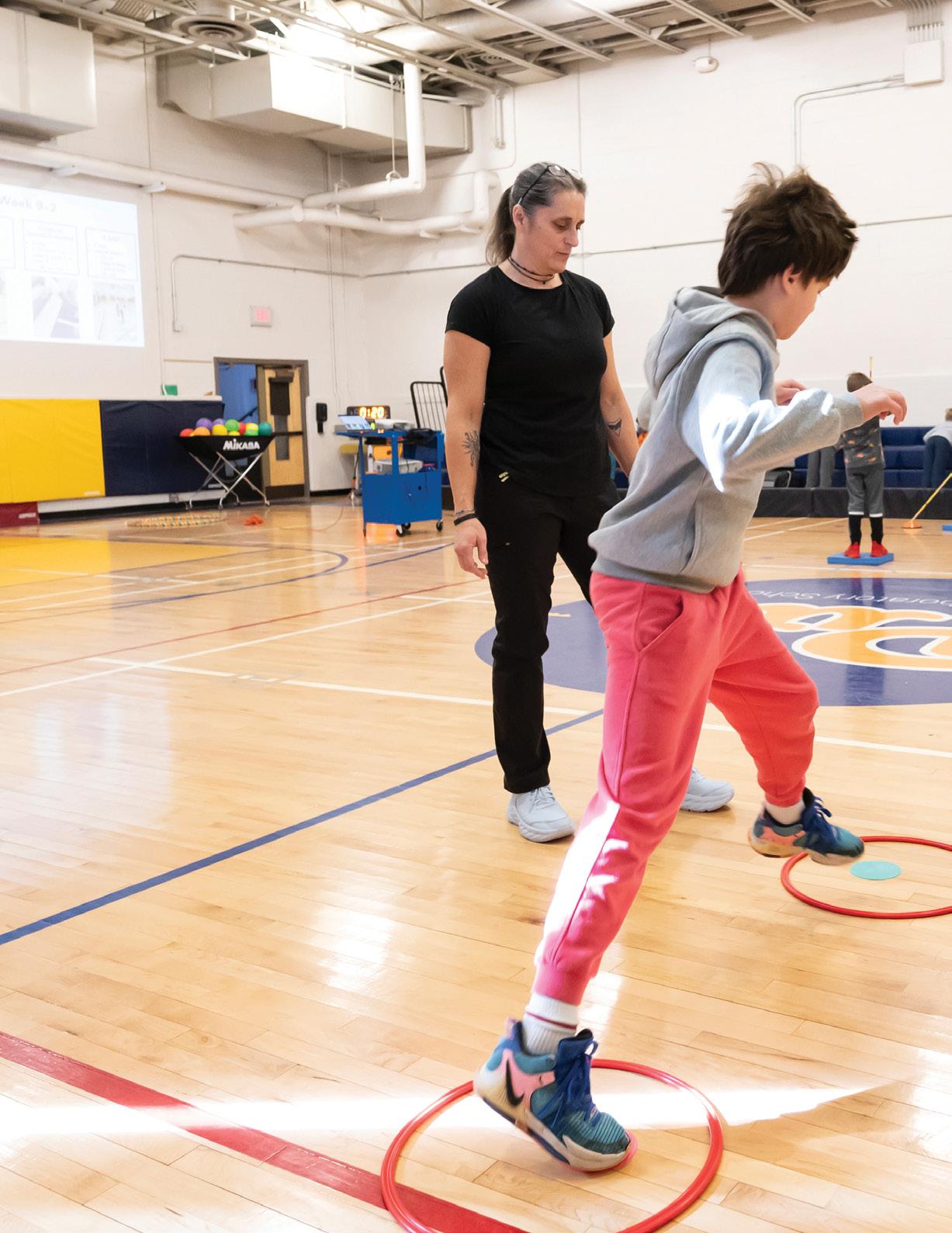
■ BY CAITLIN CHANG
What would happen if students were challenged to take control of their fitness journey from a young age? Are there ways to make physical literacy accessible and exciting to elementary students?
At the University of Pittsburgh School of Education’s Fanny Edel Falk Laboratory School, physical education teacher Laura Hunt (BS ’98, MAT ’99) is tackling these questions with an original fitness curriculum created for students in grades three to five.
In addition to having a master’s degree in K-12 physical education, Hunt is certified as a personal trainer through the National Academy of Sports Medicine. Being a personal trainer has shown her the importance of developing essential fitness skills at a young age.
“My big thing is [that] you want to be strong for life,” she explains. “Think of how many times you squat down and have to get back up. Think of, as you get older, how critical your balance is so you don’t fall down. There [are] a lot of reasons to stay fit that connect to your daily life.”
With this in mind, Hunt developed the Integrated Fitness Program at Falk to target four crucial fitness areas: core; balance; strength/endurance; and speed, agility, and quickness. Each class period, students rotate through fitness stations for threeminute intervals. For guidance, they watch an instructional slide with a suggested number of sets and repetitions and a GIF to model that station’s exercise. After the rotations, the students transition to more traditional activities like popular sports, Harry Potter tag, and badminton.
Although the students don’t know this, Hunt designed the yearlong curriculum to follow a progression. First, the students work toward building stabilization; then endurance; then strength; and then, finally, power. She also incorporated mini lessons into the curriculum to teach students about muscle groups like the core. That way, she explains, “they have a better understanding of what they’re working with in their body.”
Photography by Aimee Obidzinski
One of the biggest challenges of the program, Hunt says, is the setup and cleanup time required for the drill stations, but the students have rallied to make it work.
When a class finishes its 12-minute rotation, the students immediately start cleaning up to prepare for the day’s main activity. Then at the end of class, they set the drills back up for the students coming in after them—a courtesy that aligns with Falk’s Wish #10 for Our Children, “To be aware of the space around them and share in its maintenance.”
Many of the class’s fitness program activities—pushups, planks, and squats, for example—are carried over from Hunt’s time in personal training, but she also tailors her plans to the students, choosing what she thinks will excite or empower them the most.
“I think Ms. Hunt’s core exercises and arms exercises are really good,” one fifth grader says, while others enjoy running and jumping for ladder drills or challenging themselves with strength training.
The program also is designed to promote autonomy by allowing students to take things at their own pace.
“They get to be in control of the fitness themselves,” Hunt explains. “If I say 10-20 reps and they can only do five— maybe they’re not feeling well, maybe they just couldn’t do it—they do five. They have the choice.”
“I like the way we can take a break when we need to,” another fifth-grade student shares. “If you can’t do a certain thing, you can always ask Ms. Hunt to help you.” At the same time, students have enjoyed pushing themselves to achieve things they never knew they were capable of.
“I think they really like challenging themselves with this stuff,” Hunt says. “They’re not complaining, they’re not trying to sit out—they’re doing it.”
In addition to supporting Falk’s Wish #1 for Our Children (“To understand that any learning endeavor depends primarily on them”), this setup also has led to a significant increase in student confidence and engagement, particularly for those who haven’t historically enjoyed physical education.
Students have even begun to recognize the connection between fitness training and functional daily living, one of Hunt’s primary motives for introducing the program. The other day, “there were three girls carrying a big, giant box of books to the library, and I happened to be walking past,” Hunt says, “and they were like, ‘Look, Ms. Hunt, we’re using our core!’”
Another student, in fourth grade, recently shared that his favorite part of the program is that “it gives you strength for when you’re older.”
Falk Laboratory School’s Wishes for Our Children is a set of 21 hopes created by Falk educators for their students. The wishes, which touch on everything from physical health and nutrition to intellectual interest and the importance of friendship, reflect Falk’s educational philosophy and guide the school’s day-to-day work.
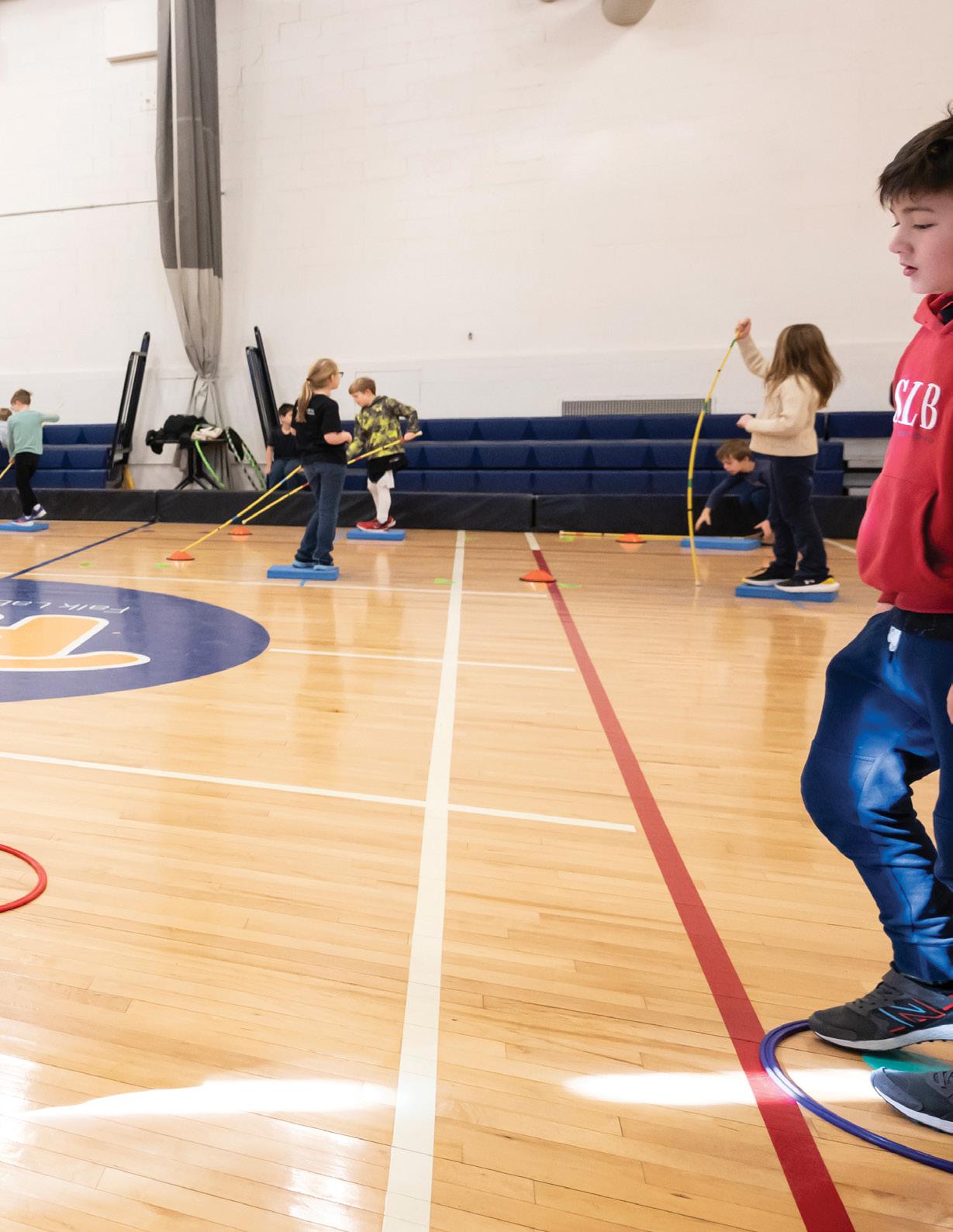
One of Falk’s goals as a laboratory school is to encourage faculty members to engage with innovative curriculum design. Hunt says that this freedom allowed her to experiment with a physical literacy program at the elementary level despite its being absent from most traditional curricula until at least high school. At any other school, Hunt says, “I’d be stuck with something like, ‘You’ve got to meet this standard, you’ve got to meet this standard.’ The thing about teaching at Falk is [that] you do have the flexibility, you can go off the interest of the kids, and these kids are interested in this.”
Another unique aspect of the program is the widespread collaboration with other adults in the building. Grades K-5 Division Director Autumn Dillaman, for instance, helped to create the Google slide template that Hunt uses to display the instructions for each day’s exercises.
Then, in addition to featuring GIFs of students (who are always eager to be recorded, have their exercise form evaluated, and have the honor of appearing on a slide), Hunt began including footage of Falk’s teachers and even the school’s director, Jill Sarada, carrying out the exercises. That way, “students will also see that the adults in the building are into fitness,” Hunt says, showcasing Falk’s commitment to lifelong learning and authentic studentteacher engagement.
The Integrated Fitness Program also reflects Falk’s Wish #18 for Our Children, “To engage in physical activities that become meaningful in their lives.” As Hunt puts it, “Now they know [these skills] for a lifetime. They’re ahead of the game in terms of fitness.” ■

■ BY JUNIOR GONZALEZ

Photo by Alex Mowrey/Pitt Athletics
Giorgiana Zeremenko has had a lifelong love affair with softball.
Growing up in Canonsburg, south of Pittsburgh, she dreamt of playing the sport in college and, maybe someday, professionally.

One important element in refining her craft is training. In many ways, it is an education of the body—learning how to get stronger, knowing your limits, and, sometimes, even surprising yourself past your perceived limits.
“I thoroughly enjoy being in a weight room. It’s one of the things I’m most passionate about,” Zeremenko, or G, as she prefers to be called, said. “So, it felt like a no-brainer on the academic side of things to choose exercise science,” the 2018 Pitt Education alumna said.
By her own measure, G realized her dreams. She played for the Pitt softball team for three years and was later picked 19th overall by the Mobile, Alabama E1 Pro Ballers in the American Softball Association Draft, becoming Pitt’s first softball player to be selected in a professional draft. After a stint in the pros, G transitioned to coaching, first in Illinois and in August 2023, back at Pitt as an assistant coach for the Panther softball team.
“My coaches, my professors—all those people were such great mentors for me and helped me grow,” said G. “My mission since going to school has been to help be that bridge and help be that person for other athletes. It’s hard not to want to give back in some capacity.”
G’s journey and philosophy reflects those of many Pitt Education student-athletes: one of immense sacrifice, determination, and joy in the pursuit of excellence. It takes several villages—one’s family at home, teammates and coaches on the field, and professors and advisors at school—working in tandem to support their endeavors.
Terms such as “time management” and “discipline” are widely recognized pillars for academic success. But for many Pitt Education student-athlete alumni, it is the foundation of a long list of accountability measures.
Chantee Earl, an assistant professor at Georgia State University, remembers the often-used “you are a student first” line, but it resonated when said by the right person. In Earl’s case, it came from her former Pitt track-and-field coach, Steve Lewis. Upon reviewing a negative academic progress report, Lewis would prohibit underperforming students from the track and assign them to study hall or to seek assistance from a professor.
“That is something I have carried with me in my approach to teaching my student-athletes today,” Earl said. A six-time All-American, Earl is one of Pitt’s greatest middle-distance runners ever, and in 2020 was inducted into the Pitt Athletics Hall of Fame.
Setting goals is paramount, according to Pitt Panthers Hall-of-Famer and Pitt Education alumna Donna Sanft. She says defining strategies and progressions for how to achieve goals played a huge role in her trailblazing time as a student-athlete competing as part of the first Pitt women’s gymnastics team in the 1970s. “You can’t just go through it blindly,” she said.


Sanft was hired as the women’s varsity gymnastics coach at 22—just before graduating from the Pitt School of Education with her degree in education.
She ended up spending her entire career with the Panthers, from coach to educator to administrator over three decades before retiring in 2014 as Executive Associate Athletic Director & Associate Dean of Students. Along the way, she inspired countless student-athletes, including an impressionable Joseph Villani.
Sanft oversaw a program called Panther Athletes Working with Students (PAWS), where student-athletes from various Pitt varsity teams would provide sport instruction as well as life skills programming to local young people through the Pitt Education Community Leisure Learn Program. During one Saturday session she saw Villani, who was a center for Pitt’s football team, volunteering to work with the students.
“I remember being very impressed by him,” said Sanft. Despite all the “noise and activity” in Trees Hall that day, Villani engaged with students in a relatable and compelling way.
“Joe was so positive, organized, and a great communicator—so clear about everything,” said Sanft. “He was a real leader and was focused on making sure each individual kid was participating.”
Sanft walked up to Villani and mentioned what she noticed about his interactions with the students.
Villani still remembers the conversation, even though it’s been 20 years.
“I wanted to be a lawyer,” he recalls telling Sanft. “Yeah…” Sanft responded in a tentative tone. “You’d be


YOU’D BE A GOOD LAWYER, BUT YOU’RE REALLY GOOD WITH KIDS. YOU SHOULD “ BE AN EDUCATOR . “ Donna
Sanft


a good lawyer, but you’re really good with kids,” she said. “You should be an educator.”
Up until that point, Villani was against it. His mother was a teacher, and while he admired her, he struggled to envision himself as a teacher for the perceived repetitive routines of teaching daily. “I didn’t see it until she said it,” Villani said of Sanft’s remark. “And then it stuck with me.”
Villani finished his studies at Pitt with a degree, achieving a double major in history, and communication and rhetoric. He was soon signed as a free agent into the NFL and had brief stints for several years with teams, including the Atlanta Falcons, New York Jets, and Tampa Bay Buccaneers, as well as playing in the Arena Football League.
After finishing his professional football career in 2009, Villani pivoted toward Sanft’s advice, enrolling in the School of Education’s Master of Arts in Teaching program. He is now principal of Bethel Park High School and will become assistant superintendent at Bethel Park School District this fall.
The road to scholarship can be a long and difficult undertaking, but student-athletes have a special DNA to handle the stress of such rigor.
Villani transferred his approach on the football field to his classes. “I always touted myself on how I prepared,” he said. Whether it was film study, weightlifting, preparation in the training room, or any exam, he cracked down on his work. “Nobody was going to prepare harder than I did,” said Villani. “That’s the same approach I take in my career.”

Being able to judiciously prioritize is what Earl tries to impress upon undergraduate student-athletes taking her classes. “Many of the principles that you use in motivating students you find on the athletic field,” she said.
Setting high expectations, accepting failure, grappling with loss, and using it as inspiration to bounce back, is what Earl says gives student-athletes “a responsive and peculiar perspective” as educators.
But it doesn’t come easy to everyone.
Tilly Sheets, associate director of academic support

services for Pitt Athletics, compared the balance to a rubber band. “If you stretch something in one direction really, really far, it gets very thin, but if you stretch something really far in two directions, it’s likely to break,” Sheets said.
“There needs to be a happy medium of stretching someone athletically and academically where they feel they’re well-balanced,” added Sheets, who earned her EdD in higher education management at the Pitt School of Education in 2022. “It’s a very good lesson for life in general.”
Sheets’ doctoral dissertation focused on finding holistic approaches to support student-athletes. The ever-evolving dynamics of collegiate sports can be overwhelming, she said, but connecting students to the right help is key.
“There’s so many layers of support available for all students, but specifically for student-athletes,” said Sheets. Among them is Pitt’s Academic Support Services for Student Athletes (ASSSA) program, which provides counseling, tutoring, and ample study space at the Hilda M. Willis Academic Center in the Petersen Events Center.
Sheets juggled her academic schedule with an exceptional swimming career while an undergraduate at Clarion University (now PennWest Clarion), where she ended her time as a 28-time NCAA Division II Women’s Swimming All-American, among dozens of other accolades. After 15 years of coaching studentathletes between Clarion and Chatham, she came to Pitt and changed her focus to the academic side of the student-athlete equation.
“I feel like I can be very useful in helping women who want to pursue careers in sports,” said Sheets.
Acts of service run deep for former student-athletes who found meaning through sport. After graduation, many move into coaching as G, Sanft, and Sheets did. Teachers like Villani and Earl continue in the academic space, and others move into clinical realms such as physical therapy or medicine.
But no matter the field, the transition can present new personal challenges. “When you first finish playing and you’re still big and capable, it’s a struggle mentally,” said Villani, “because you start to wonder: Where do you apply and put those efforts?”
Sheets found her calling through helping students recognize and explore those post-collegiate options. There’s always a path for a talented athlete to refine their skills from K-12 through college, notes Sheets, but the path after college is open-ended. “Hopefully at some point in their college experience, that light bulb goes on and they think, ‘“Oh, this is going to end, and I’m going
to have to go be a productive member of society in a different way.’”
Her motto for academic advising is having power with people, not power over people. “Making student-athletes a partner in the process—giving them ownership to explore options versus just telling them what they need to do—is a very helpful experience,” said Sheets, “because on the athletic side of things, a lot of decisions are made for them.”
Earl’s path to teaching came through trial and error during her undergraduate years. Initially on a pre-med track, she took a human anatomy class in her junior year and struggled upon walking into a lab with cadavers.
“I couldn’t stomach it,” said Earl. “I was encouraged to consider other avenues.”
Soon enough, through a volunteer opportunity for Pitt athletes, Earl caught the teaching bug at an elementary school in the Pittsburgh neighborhood of Mount Washington, and her focus became clear.
After continuing her studies at Pitt with a Master of Arts in Teaching, Earl taught high school social studies in California. She returned to Pitt Education once more to earn her PhD in secondary education.
In no small part, she attributes that focus to the values instilled by her coaches. “They made sure we understood that there would be life outside of track. To prepare for that life, we had to achieve academically.”
According to Villani, that education—or training—has a big impact down the line since it becomes a mindset. “As a teacher, you’re not just teaching them curriculum, you are giving them purpose.” he said. Even if a student doesn’t grasp a subject at hand, the right messenger could make all the difference. “Those teachers I had at Pitt, I took those classes because I wanted to be around them,” said Villani.
“It becomes about understandings, about applying it to solving problems, figuring things out, and becoming a valuable asset in whatever you decide to do in your life,” Villani said. “That’s what education is, and that’s why student-athletes make great educators.” ■
“ IT BECOMES ABOUT UNDERSTANDINGS, ABOUT APPLYING IT TO SOLVING PROBLEMS, FIGURING THINGS OUT, AND BECOMING A VALUABLE ASSET IN WHATEVER YOU DECIDE TO DO IN YOUR LIFE. THAT’S WHAT EDUCATION IS, AND THAT’S WHY STUDENT-ATHLETES MAKE GREAT EDUCATORS . “ Joseph Villani

David Beck (EdD ’20) was named interim dean of the University of Pittsburgh School of Health and Rehabilitation Sciences in January 2025. He joined the faculty 15 years ago and most recently was the school’s executive vice dean.

David Bowlin (EdD ’04) is now the lead school improvement consultant for State Support Team Region 2 in Ohio.

Jinfa Cai (PhD ’94), the Kathleen and David Hollowell Professor of Mathematics Education at the University of Delaware, has been elected to the National Academy of Education.

Shannon Clifford (BS ’99) has been named acting dean of the Marjorie K. Unterberg School of Nursing and Health Studies at Monmouth University.

Kevin Conley (MS ’93), associate dean for undergraduate studies and chair of the Department of Sports Medicine and Nutrition at Pitt’s School of Health and Rehabilitation Sciences, received a 2024 Distinguished Alumni Award from SUNY Cortland.

Louis Deemer (MEd ’20) received the 2024 NAFSA Rising Star Young Leader Award in recognition of his impact as an immigrant specialist in Pitt’s Office of International Services.

Jamilah Ducar assistant vice chancellor of the engaged campus in Pitt’s Office of Engagement and Community Affairs, was named to City & State Pennsylvania’s 2024 Forty Under 40 List, which recognizes young Pennsylvanians making an impact across the commonwealth.

Kate Flickenger (MS ’15, PhD ’22), principal physiologist in the Applied Physiology Laboratory in Pitt’s Department of Emergency Medicine, was selected as a 2024 Translational Research Institute for Space Health fellow. The fellowship is in recognition of her work studying the benefits of sleeping in space.

Beth Genter (MS ’90), founder and president of Schenley Capital in Sewickley, Pennsylvania, received the 2024 Partner in Philanthropy Award from The Pittsburgh Foundation.
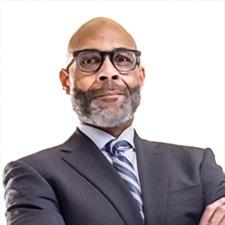
Christopher Everette Howard (BS ’11) published a new book, “Wellness Beyond Weight Loss: Transcending the Scale and Finding Fulfillment.”

Jefferson Award from the Pennsylvania chapter of Multiplying Good. The award recognized his volunteer work through the organization’s ChangeMakers program.

Jason Miller (MAT ’07, EdD ’22) was named chief wellness officer at Robert Morris University near Pittsburgh. He oversees the strategy, administration, and operational oversight of wellness initiatives across the university.

Ayisha Morgan-Lee (EdD ’20) is the founder of Hill Dance Academy Theatre in Pittsburgh, which recently was named one of Pittsburgh’s 16 Cultural Treasures by the Heinz Endowments and Ford Foundation for its role in preserving and honoring Black arts.

honorable mention from Pitt’s Gender, Sexuality, and Women’s Studies Program in the Kenneth P. Dietrich School of Arts and Sciences.
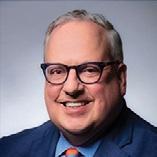
Christopher Reber (PhD ’87), president of Hudson County Community College in Jersey City, New Jersey, was named 2024 CEO of the Year by the American Association of Community Colleges.
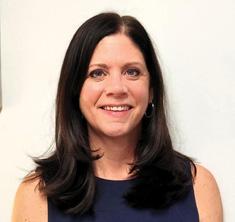
Rebecca Renshaw (MEd ’99, PhD ’10) was named executive director of the Western Pennsylvania School for Blind Children in Pittsburgh. She also is board president of the Association for the Education and Rehabilitation of the Blind and Visually Impaired.


Allison Saras (PhD ’16) has been named director of development for the Donald P. Bellisario College of Communications at Pennsylvania State University.
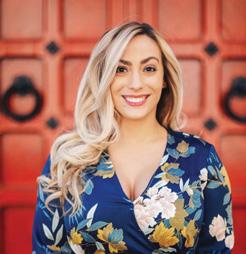
Ashley Shafer (BS ’14, MS ’16, PhD ’23), a postdoctoral fellow in Pitt’s Office of Child Development, was selected as a Home Visiting Applied Research Collaborative fellow for 2024-25.

Charles Small (EdD ’13) was named senior associate athletic director of sport administration at the University of Washington in August 2024.

Science Education Leadership Association and began his term in June 2024.

Anastasia White (MEd ’23), senior director for strategic programs and services in Pitt’s School of Health and Rehabilitation Sciences, received the 2023-24 Chancellor’s Award for Staff Excellence for Commitment to Equity, Diversity, and Inclusion.
Have you changed jobs or received a promotion? Let us know by emailing soenews@pitt.edu. In addition to printing updates in the magazine, we share alumni news on the School of Education social media channels and through articles on the school website, education.pitt.edu.
To update your alumni information, please contact Michael Haas, director of development and alumni affairs at Pitt Education, at mbh26@pitt.edu
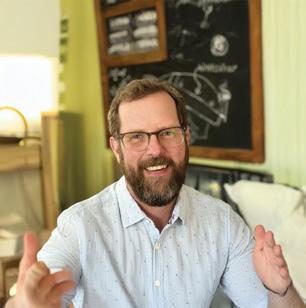
Chad Dorn (PhD ’18) died on July 25, 2024, at the age of 47. He worked as director of community impact and evaluation for Leading to Movement and was an adjunct professor at Rowan University in Glassboro, New Jersey.

Joseph W. Gilkey Sr. (BS ’60, EdD ’70) died on Dec. 5, 2024, at the age of 93. A U.S. Air Force veteran who served in the Korean War, he later worked for more than 30 years in the Smithtown Central School District in Smithtown, New York.

Rita J. Gob (BA ’73) died on July 27, 2024, at the age of 92.
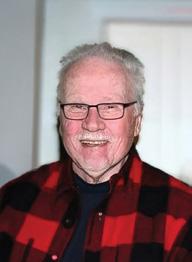
Bruce Noble, a former School of Education faculty member, died on April 6, 2025, at the age of 90. He taught at Pitt from 1965-76 and was an elected fellow of the American College of Sports Medicine.
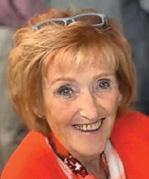
Kathryn L.W. (Ward) Rudy, a former employee of the University of Pittsburgh Office of Child Development, died on Feb. 18, 2025, at the age of 77. Rudy worked on the Care Break initiative, which provided respite care for children with disabilities, and was part of the St. Petersburg-USA Orphanage Research Team.
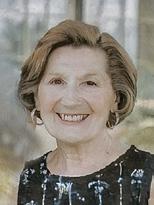
Maria D. Stephenson (BS ’62) died on Nov. 2, 2023.
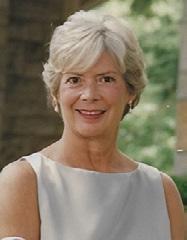
Carol (Single) Stilley (MEd ’92, PhD ’97) died on Jan. 12, 2025, at the age of 83. She taught and conducted research at the Pitt School of Nursing for more than 18 years. Stilley was the mother-in-law of Elizabeth Nagle, associate professor of practice and associate cochair of the Department of Health and Human Development at the Pitt School of Education.

William “Bill” Aldophus Granberry Fisher — a revered University of Pittsburgh alumnus and pioneering educator who became the first Black principal to serve at a predominantly white Pittsburgh public high school — died on April 13. He was 100.
Described as a caring, dedicated force of nature, Fisher earned a bachelor’s degree in education from Pitt in 1948 and set about making the public school system, of which he was a product, work for everyone. He believed all students deserved the best education possible.
In 1971, Fisher made history when he became the first African American principal of Taylor Allderdice High School in the city’s Squirrel Hill neighborhood.
He started the job amid the tumult of desegregation. It was a tense and sometimes violent time: Fights were common, and students would often leave school to escape
■
BY ERVIN DYER
the aggravations. Nonetheless, he soon became a beloved and cherished principal, thanks in part to his warm but firm rapport with his pupils. Former students say Fisher saw potential in each of them and pushed everyone to be their best.
He earned the nickname “Hook” for his insistence that young men take off their caps indoors or else hang them up on hooks in his office and for his pursuit of students who cut school — he’d hook them back into their classes.
Fisher retired in 1991, but not before shaping the lives of hundreds of students, many of whom would go on to Pitt. For African American students and teachers, he paved the way for them to rise into leadership roles within Pittsburgh Public Schools.
(continued on page 34)
(continued from page 33)
“William Fisher, a proud alumnus of the School of Education, exemplified the transformative power of education. As the first Black principal at Allderdice High School, he left an indelible mark on countless students, inspiring them to make a positive impact on the world,” said Eboni M. Zamani-Gallaher, Renée and Richard Goldman Dean and Professor at Pitt’s School of Education.
Above all, she added, Fisher “stood as a possibility model for others, demonstrating the remarkable achievements attainable with an education degree. His legacy continues to endure through the many lives he touched.”
During his senior year, Fisher became the first Black male student to be elected by his peers to an honorary group then called the Pitt Hall of Fame, a recognition of exemplary leadership. His name is inscribed in stone along the walk of achievement from Heinz Memorial Chapel to the Cathedral of Learning.
“ GETTING ACCEPTED MEANT I COULD LIVE UP TO THE EXPECTATIONS THAT MY GRANDMOTHER HAD FOR ME TO SUCCEED . “
William Fisher

After graduating from the University, Fisher worked for a few years as a clerk and a manager for the Pennsylvania Unemployment Office in Pittsburgh’s Hill District. Then, in 1955, he became a teacher at the neighborhood’s Fifth Avenue High School, taking his first steps toward his trailblazing education career.
Early on, Fisher created the first parent-teacher organization at a Pittsburgh public high school and taught the district’s first class in Negro history. In the second year of his teaching career, he was honored as one of the 10 best teachers in Pittsburgh with the Edgar Stern Award.
It would not be long before Fisher went on to earn a master’s degree in education from Duquesne University. Shortly after, he soared into high-level administration, becoming a vice principal at Westinghouse High in Pittsburgh’s Homewood neighborhood and, eventually, returning as vice principal to Fifth Avenue High, where he stayed for 11 years.
His next move was to Taylor Allderdice High School in 1971. Few would forget his service as principal.
In June 2024, the class of 1972 gathered to celebrate its 50th reunion. Fisher, who had just turned 100, was an honored guest, hailed for his firmness and dedication to the students and the school
The son of a garbage hauler, Fisher grew up in the city’s East End, where he and his little brother were raised by their grandmother, Nora Durham, after their mother died at 24 from tuberculosis. At Peabody High (now Obama Academy), he was editor of the yearbook, president of the Latin Club and valedictorian of his class. He first enrolled at Pitt in 1942 but was soon conscripted to serve in World War II. He came back to campus in 1946, this time with help from the GI Bill.
“I was thrilled to be at Pitt,” recalled Fisher in 2023 interview with Pitt Magazine. “Getting accepted meant I could live up to the expectations that my grandmother had for me to succeed.”
He participated in the University’s Interfraternity Council, Men’s Council and Debate Club and served as a Pitt Player, doing scenery and backstage work for the theater ensemble.
But Fisher perhaps found his greatest calling with Alpha Phi Alpha, the first Black male fraternity on Pitt’s campus. The brotherhood provided Fisher a deeper belonging and reinforced a personal belief in “being the master of your fate.”
In 2022, Fisher received a Distinguished Alumnus Award from the Pitt African American Alumni Council (AAAC).
AAAC National President Thomas Brooks said Fisher’s service to the University and the fraternity “exemplified the highest ideals of service and leadership, inspiring generations past and present.”
Details on funeral arrangements have not been disclosed. ■
This story originally appeared in Pittwire. Read more at pittwire.pitt.edu.
by

■ BY MARK NOOTBAAR
John Wilds (MEd ’70, PhD ’78), a long-serving member of the University of Pittsburgh School of Education Alumni Society Board, was recognized with the prestigious Bill Baierl Distinguished Alumni Service Award for his unwavering commitment to volunteer service at the University of Pittsburgh.
Given to Wilds during the University’s 2024 homecoming celebration, this award commemorates the late William R.Baierl (EDUC ’51), a notable Western Pennsylvania businessman and generous benefactor to Pitt.
Wilds served the University in various high-level administrative roles for more than three decades. He is the former director of the Office of Human Resources and the former assistant vice chancellor for community relations. Additionally, his leadership was instrumental in establishing community-based partnerships that led to the creation of Pitt’s Community Engagement Centers (CECs).
“During his decades at Pitt, John championed the University’s role as a partner and resource to our communities,” says Lina Dostilio, Pitt’s vice chancellor for engagement and community affairs, who was highly recommended by Wilds to build the CECs. “Today, John’s influence is felt in every aspect of how the Office of Engagement and Community Affairs operates.”
Along with his professional commitment to the University, Wilds has long been a financial supporter. He made his first gift to the University in 1975 and has given nearly every year since. He splits his giving among funds associated with the African American Alumni Council, the School of Education, and the Department of Athletics.
“In life, you have to give back,” says Wilds. “If you can make the world a better place for someone else, you should do that. I’ll support Pitt financially and volunteer until I am no longer able.” ■
BY MARK NOOTBAAR

Renée K. Goldman (MEd ’64) and Richard M. Goldman (MEd ’66, PhD ’70) are the embodiment of serial social entrepreneurs. Every business they start is more innovative than the last, and each one is centered on helping others to achieve their dreams.
During the 2024 homecoming celebration, the Goldmans received the University of Pittsburgh Distinguished Alumni Fellow award. As the most prestigious alumni award conferred by the University, the honor is reserved for prominent alumni who have made an impact locally, nationally, and globally. The award is given by the Pitt Alumni Association in partnership with the Office of the Chancellor.
“Our Pitt education introduced us to the concepts and foundations that have been a thread through all of our businesses,” Renée Goldman says. “Pitt had a profound influence on what we have done and who we are.”
The Goldmans’ first entrepreneurial endeavor came in 1984, when the couple transformed the preschool industry by opening a facility focused on educating pre-K children as opposed to the standard of the day, which was largely focused on babysitting. It became one of the first preschools to be educationally accredited.
The Goldmans’ next business was a K-12 school that introduced a wireless laptop program that used technology in ways that were decades ahead of many other primary and secondary schools. The success of the concept led to the creation of one of the nation’s first fully online high schools.
The Goldmans continued to innovate, launching an online school for adults to earn their high school diplomas. Companies including McDonald’s send their employees to the school, which now boasts 15,000 graduates. The Goldmans’ current focus is Xceed Preparatory Academy, a series of hybrid/micro schools. Students work in openconcept spaces on their own schedules with teachers acting like coaches.
In 2014, the Goldmans made a transformative gift to Pitt, which was recognized with the naming of the Renée and Richard Goldman Dean of the University of Pittsburgh School of Education.
“Your memory lives as long as the last person mentions your name,” Richard Goldman says. “We want to be remembered as supporting the right issues and a great institution, so we thank Pitt for attaching our name to such a good thing.”
The Goldmans continue to support Pitt annually; meet with other donors about planned giving techniques; and, most importantly, are always available to speak with the dean, faculty, and students about the latest trends in education. ■
Support future education leaders by making a philanthropic gift to the School of Education. To learn more, contact Michael Haas, director of development and alumni affairs at Pitt Education, at mbh26@pitt.edu
We strive for well-being for all. We teach. We commit to student, family, and community success. We commit to educational equity. We advocate. We work for justice. We cultivate relationships. We forge engaged partnerships. We collaborate. We learn with and from communities. We innovate and agitate. We pursue and produce knowledge. We research. We disrupt and transform inequitable educational structures. We approach learning as intertwined with health, wellness, and human development. We address how national, global, social, and technological change impacts learning. We shape practice and policy. We teach with and for dignity. We think. We dream. We lead with integrity. We are the School of Education at the University of Pittsburgh.